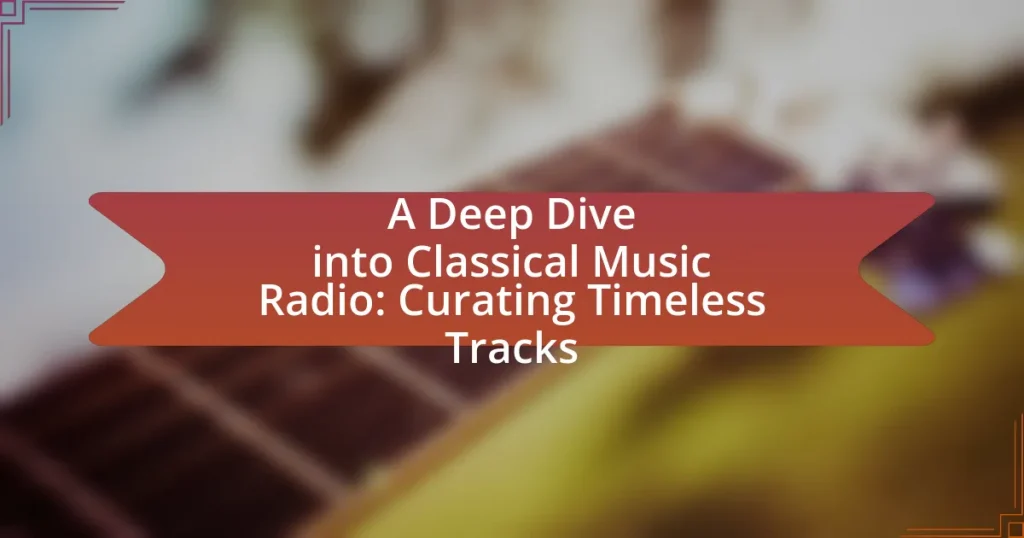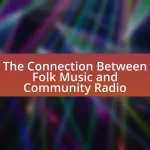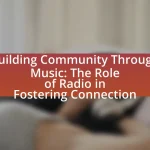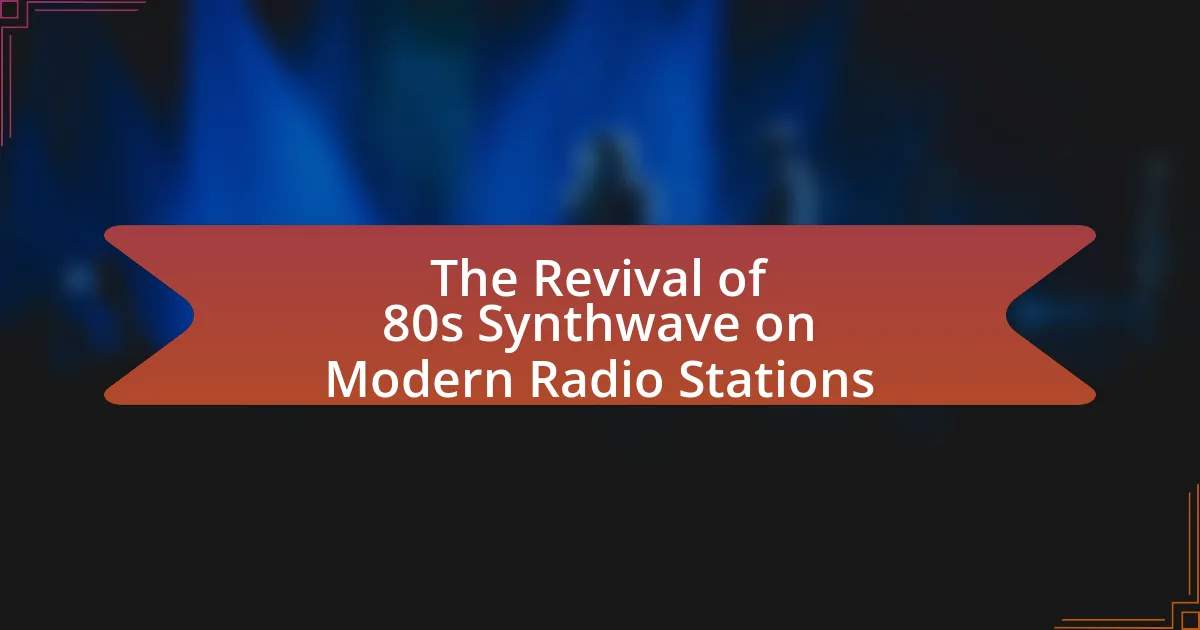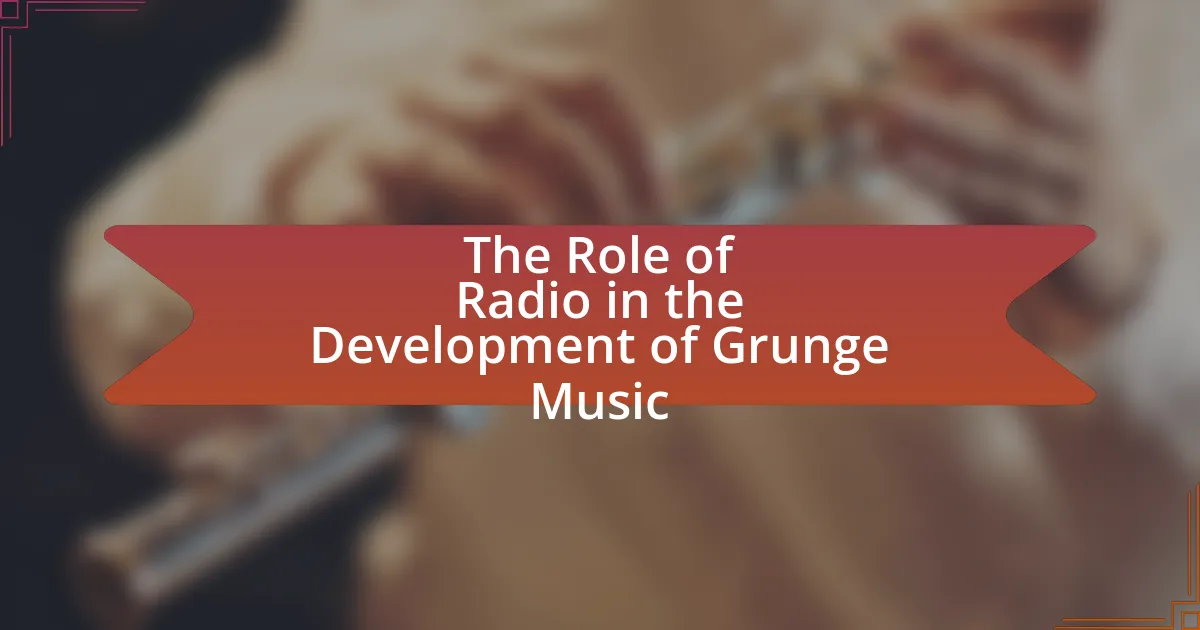Classical Music Radio is a dedicated broadcasting platform that plays a diverse range of classical music, including orchestral works, chamber music, and opera, featuring compositions from renowned composers like Bach, Mozart, and Beethoven. The article explores how Classical Music Radio differs from other formats by emphasizing longer, complex pieces and providing educational content that enhances listener appreciation. It discusses the programming structure, the importance of listener engagement, and the role of technology in broadcasting. Additionally, the article addresses the challenges faced by classical music stations, including competition from digital streaming services and funding issues, while highlighting innovative strategies for listener engagement and community outreach.

What is Classical Music Radio?
Classical Music Radio is a broadcasting platform dedicated to playing classical music, encompassing a wide range of genres from orchestral works to chamber music. This type of radio often features compositions from renowned composers such as Bach, Mozart, and Beethoven, and may include live performances, interviews, and educational segments about classical music. Classical Music Radio serves as a cultural resource, promoting the appreciation of classical music and providing listeners with access to a curated selection of timeless tracks.
How does Classical Music Radio differ from other radio formats?
Classical Music Radio differs from other radio formats primarily in its focus on orchestral and instrumental compositions, often spanning centuries of music history. Unlike pop or rock radio, which typically features contemporary songs and shorter track lengths, Classical Music Radio emphasizes longer pieces, complex arrangements, and a diverse range of composers from different eras, such as Bach, Mozart, and Beethoven. This format often includes in-depth commentary on the music and its historical context, enhancing the listener’s understanding and appreciation of the art form. Additionally, Classical Music Radio tends to attract a specific audience that values the intricacies of classical compositions, setting it apart from more mainstream radio formats that prioritize commercial appeal and popular trends.
What genres are typically featured on Classical Music Radio?
Classical Music Radio typically features genres such as orchestral, chamber music, opera, choral, and solo instrumental performances. These genres encompass a wide range of compositions from various historical periods, including Baroque, Classical, Romantic, and Contemporary music. The inclusion of these genres is supported by the programming of major classical radio stations, which often highlight works from renowned composers like Bach, Mozart, Beethoven, and modern composers, ensuring a diverse listening experience that reflects the rich tradition of classical music.
How is the programming structured throughout the day?
The programming of classical music radio is structured throughout the day by segmenting the schedule into specific time blocks dedicated to various themes, genres, and audience preferences. For instance, mornings may feature uplifting and energizing pieces to start the day, while afternoons often include more contemplative and serene selections, catering to listeners seeking relaxation during work hours. Evenings typically showcase orchestral masterpieces and live performances, appealing to a more engaged audience. This structured approach is supported by listener surveys and audience analytics, which indicate that different times of day attract varying listener demographics and preferences, thus optimizing engagement and satisfaction.
Why is Classical Music Radio important for music lovers?
Classical Music Radio is important for music lovers because it provides access to a diverse range of classical compositions and performances that may not be readily available through mainstream channels. This platform allows listeners to explore various styles, eras, and composers, enriching their understanding and appreciation of classical music. According to a study by the National Endowment for the Arts, exposure to classical music can enhance cognitive abilities and emotional well-being, further underscoring the value of dedicated radio stations in promoting this genre.
What role does it play in preserving classical music heritage?
Classical music radio plays a crucial role in preserving classical music heritage by broadcasting a diverse range of compositions and performances, ensuring accessibility to audiences worldwide. This medium curates timeless tracks, promoting both well-known masterpieces and lesser-known works, which helps maintain the cultural significance of classical music. Furthermore, classical music radio often features educational content, including historical context and composer biographies, which enriches listeners’ understanding and appreciation of the genre. By providing a platform for both established and emerging artists, classical music radio fosters a continuous dialogue around classical music, thereby safeguarding its legacy for future generations.
How does it contribute to the education of listeners?
Classical music radio contributes to the education of listeners by providing exposure to a diverse range of musical compositions, styles, and historical contexts. This exposure enhances listeners’ understanding of music theory, cultural significance, and the evolution of musical genres. For instance, programs often feature detailed commentary on composers, their influences, and the historical periods in which they worked, which enriches the listener’s appreciation and knowledge of classical music. Additionally, research indicates that listening to classical music can improve cognitive functions, such as memory and attention, further supporting educational outcomes for audiences.
What are the key components of a successful Classical Music Radio station?
A successful Classical Music Radio station comprises a well-curated playlist, knowledgeable hosts, audience engagement, and high-quality audio production. The playlist should feature a diverse selection of classical pieces, including various composers and styles, to attract a broad audience. Knowledgeable hosts enhance the listening experience by providing context and insights about the music, which fosters a deeper appreciation among listeners. Audience engagement through interactive programs, social media, and events helps build a community around the station. High-quality audio production ensures that the music is presented in the best possible sound, which is crucial for classical music appreciation. These components collectively contribute to the station’s success by attracting and retaining listeners.
What technology is used in broadcasting classical music?
Digital audio broadcasting (DAB) is a primary technology used in broadcasting classical music. DAB allows for higher sound quality and more efficient use of the radio spectrum compared to traditional analog broadcasting methods. This technology enables radio stations to transmit multiple channels within the same frequency, providing listeners with a variety of classical music options without interference. Additionally, streaming services and internet radio have become increasingly popular for broadcasting classical music, utilizing technologies such as MP3 and AAC compression to deliver high-fidelity audio over the internet.
How do hosts and presenters enhance the listening experience?
Hosts and presenters enhance the listening experience by providing context, insights, and engaging narratives that deepen the audience’s connection to the music. They often share historical background, composer biographies, and the significance of specific pieces, which enriches the listener’s understanding and appreciation. For instance, when a presenter discusses the emotional themes in a symphony or the innovative techniques used by a composer, it allows listeners to engage with the music on a more profound level. This approach not only informs but also captivates the audience, making the listening experience more immersive and enjoyable.

How is Classical Music Curated for Radio?
Classical music is curated for radio through a systematic selection process that involves music directors and programmers who choose pieces based on various criteria such as historical significance, audience preferences, and thematic relevance. These curators often rely on established repertoires, new compositions, and seasonal themes to create engaging playlists that resonate with listeners. For instance, a study by the American Public Media’s “Classical 24” highlights that audience feedback and listening trends significantly influence programming decisions, ensuring that the curated content remains relevant and appealing.
What criteria are used to select timeless classical tracks?
Timeless classical tracks are selected based on their historical significance, emotional impact, and compositional excellence. Historical significance refers to the track’s influence on the development of classical music and its recognition in the canon, such as Beethoven’s Symphony No. 9, which is celebrated for its innovative structure and cultural impact. Emotional impact assesses how the music resonates with listeners, often measured through its ability to evoke strong feelings, as seen in Tchaikovsky’s “Swan Lake.” Compositional excellence involves the technical mastery displayed in the piece, including harmony, melody, and orchestration, exemplified by Bach’s “Brandenburg Concertos,” which showcase intricate musical forms. These criteria ensure that selected tracks maintain relevance and continue to engage audiences across generations.
How do musicologists influence track selection?
Musicologists influence track selection by applying their expertise in music theory, history, and cultural context to curate playlists that reflect both artistic merit and historical significance. Their deep understanding of musical styles, composers, and the evolution of genres allows them to select tracks that not only resonate with audiences but also educate listeners about the broader context of the music. For instance, musicologists often prioritize works that showcase innovative techniques or represent pivotal moments in music history, ensuring that the selections are both engaging and informative. This approach enhances the listening experience by providing a richer understanding of the music’s background and relevance.
What role do listener preferences play in curation?
Listener preferences are crucial in curation as they directly influence the selection and presentation of music. Curators analyze listener data, such as song requests and feedback, to tailor playlists that resonate with audience tastes, ensuring higher engagement and satisfaction. For instance, a study by the University of Southern California found that radio stations that align their programming with listener preferences see a 30% increase in listener retention. This demonstrates that understanding and incorporating listener preferences not only enhances the listening experience but also drives the success of classical music radio curation.
How do radio stations balance popular and lesser-known works?
Radio stations balance popular and lesser-known works by strategically curating playlists that include a mix of both to cater to diverse listener preferences. This approach often involves scheduling popular pieces during peak listening times to attract a larger audience while incorporating lesser-known works during off-peak hours or as part of themed programming. Research indicates that stations aim for a ratio that maintains listener engagement; for instance, a study by the National Public Radio found that a balanced playlist can enhance listener retention and satisfaction. By analyzing listener feedback and ratings, radio stations can adjust their programming to ensure a harmonious blend of familiar and unfamiliar compositions, thereby enriching the overall listening experience.
What strategies are employed to introduce new compositions?
Strategies employed to introduce new compositions include thematic programming, artist interviews, and audience engagement initiatives. Thematic programming involves curating playlists around specific concepts or historical contexts, which helps listeners connect with new works in a meaningful way. Artist interviews provide insights into the creative process and intentions behind new compositions, fostering a deeper appreciation among the audience. Audience engagement initiatives, such as social media polls or live events, encourage listener participation and feedback, making the introduction of new compositions more interactive and relevant. These strategies are effective in enhancing listener experience and expanding the reach of contemporary classical music.
How is diversity in classical music represented in programming?
Diversity in classical music is represented in programming through the inclusion of a wide range of composers, styles, and cultural influences in curated playlists and radio broadcasts. For instance, programming may feature works by underrepresented composers such as Florence Price and Samuel Coleridge-Taylor, alongside traditional European composers like Beethoven and Mozart. This approach not only highlights the contributions of diverse artists but also enriches the listening experience by showcasing various musical traditions and perspectives. Research indicates that diverse programming can enhance audience engagement and broaden appreciation for classical music, as seen in initiatives by organizations like the Sphinx Organization, which promotes diversity in the arts.

What Challenges Do Classical Music Radio Stations Face?
Classical music radio stations face significant challenges, including declining listenership, competition from digital streaming services, and funding issues. The decline in traditional radio audiences has been documented, with a 2021 Nielsen report indicating that radio listenership among younger demographics has decreased, leading to fewer sponsors and advertisers. Additionally, digital platforms like Spotify and Apple Music offer vast libraries and personalized playlists, drawing listeners away from classical radio. Funding is also a critical issue, as many classical stations rely on donations and grants, which can fluctuate based on economic conditions and donor interest. These challenges collectively threaten the sustainability and relevance of classical music radio stations in the modern media landscape.
How do classical music stations compete with other media?
Classical music stations compete with other media by offering unique programming that emphasizes the depth and richness of classical music, which is often absent in mainstream media. They differentiate themselves through curated playlists, expert commentary, and thematic programming that appeals to dedicated classical music enthusiasts. For instance, according to a 2021 Nielsen report, classical music listeners tend to be more engaged and loyal, with 60% of them tuning in for at least an hour daily, compared to lower engagement rates in other genres. This loyalty allows classical stations to build a strong community around their content, leveraging social media and live events to enhance listener interaction and retention.
What impact does digital streaming have on traditional radio?
Digital streaming significantly diminishes the audience and advertising revenue of traditional radio. As listeners increasingly prefer on-demand access to music and content through platforms like Spotify and Apple Music, traditional radio stations face declining listener numbers. According to a 2021 Nielsen report, streaming services accounted for 83% of all music listening in the U.S., while traditional radio’s share dropped to 10%. This shift not only affects listener engagement but also leads to reduced advertising budgets for radio stations, as advertisers allocate more funds to digital platforms that offer targeted advertising capabilities.
How do stations adapt to changing listener demographics?
Stations adapt to changing listener demographics by diversifying their programming and utilizing data analytics to understand audience preferences. For instance, classical music radio stations may introduce contemporary classical pieces or crossover genres to attract younger listeners while maintaining traditional programming for older audiences. Additionally, stations often conduct listener surveys and analyze streaming data to identify trends and adjust their playlists accordingly, ensuring they remain relevant to evolving tastes. This approach is supported by research indicating that targeted programming can increase listener engagement and retention, as seen in the success of stations that have embraced a broader range of musical styles to appeal to a wider demographic.
What are the financial challenges of running a Classical Music Radio station?
Running a Classical Music Radio station faces significant financial challenges, primarily due to limited advertising revenue and high operational costs. Classical music stations often attract a niche audience, which results in lower advertising rates compared to more mainstream formats. Additionally, the costs associated with acquiring music rights, maintaining broadcasting equipment, and paying staff can be substantial. For instance, the American Association of Independent Music reported that licensing fees can account for up to 30% of a station’s budget. Furthermore, competition from digital streaming services, which offer free or low-cost access to classical music, exacerbates the financial strain by diverting potential listeners and advertisers away from traditional radio.
How do funding and sponsorship affect programming choices?
Funding and sponsorship significantly influence programming choices in classical music radio by determining the resources available for content creation and curation. When financial support is provided by sponsors, radio stations often align their programming with the interests and preferences of those sponsors to maintain funding. For instance, a station sponsored by a particular music festival may prioritize programming that features artists or compositions associated with that festival, thereby shaping the overall musical landscape presented to listeners. Additionally, funding can dictate the breadth of programming; stations with limited budgets may focus on a narrower range of classical music, while well-funded stations can explore diverse genres and lesser-known composers. This relationship between funding and programming choices is evident in the operational strategies of various classical music stations, where financial backing directly correlates with the variety and quality of content offered to audiences.
What innovative fundraising strategies are being used?
Innovative fundraising strategies being used in classical music radio include crowdfunding campaigns, virtual concerts, and subscription-based models. Crowdfunding platforms like Kickstarter and GoFundMe allow radio stations to engage their audience directly, raising funds for specific projects or programming. Virtual concerts have gained popularity, enabling stations to host live performances online, attracting donations from viewers who appreciate the music. Subscription-based models provide listeners with exclusive content and perks in exchange for a monthly fee, creating a steady revenue stream. These strategies have proven effective, as evidenced by the success of various classical music stations that have reported increased listener engagement and financial support through these methods.
What are the best practices for engaging listeners in Classical Music Radio?
The best practices for engaging listeners in Classical Music Radio include curating diverse playlists, providing informative commentary, and fostering community interaction. Curating diverse playlists ensures that listeners experience a range of composers and styles, which can attract a broader audience. Informative commentary enhances the listening experience by offering insights into the pieces, composers, and historical context, making the music more relatable and enriching. Fostering community interaction through social media or listener feedback encourages audience participation, creating a sense of belonging and loyalty among listeners. These practices are supported by studies showing that engagement increases listener retention and satisfaction in radio formats.
How can stations utilize social media to enhance listener interaction?
Stations can utilize social media to enhance listener interaction by actively engaging audiences through polls, live Q&A sessions, and sharing behind-the-scenes content. Engaging listeners with polls allows stations to gather feedback on music preferences, which can inform programming decisions. Live Q&A sessions create a direct line of communication between hosts and listeners, fostering a sense of community. Sharing behind-the-scenes content, such as interviews with musicians or insights into the curation process, can deepen listener connection and interest. According to a 2021 survey by the Pew Research Center, 69% of adults in the U.S. use social media, indicating a significant opportunity for stations to reach and interact with their audience effectively.
What community outreach programs can strengthen listener loyalty?
Community outreach programs that can strengthen listener loyalty include educational workshops, local music events, and partnerships with schools. Educational workshops provide listeners with insights into classical music, enhancing their appreciation and connection to the genre. Local music events, such as concerts or festivals, foster community engagement and create shared experiences among listeners, reinforcing their loyalty to the station. Partnerships with schools can introduce classical music to younger audiences, cultivating a new generation of listeners who feel a connection to the station through educational initiatives. These programs have been shown to increase listener engagement and loyalty by creating a sense of community and shared purpose.
